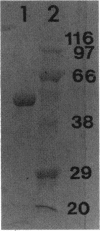Abstract
A thermostable polygalacturonate lyase (PL; EC 4.2.2.2) was secreted by Thermomonospora fusca during stationary phase in pectin-mineral salts medium at 52 degrees C. Biosynthesis was induced by addition of pectic substances to cultures growing on glucose or cellulose but not cellobiose; the disaccharide repressed enzyme synthesis and triggered inactivation of enzyme previously secreted. The PL, purified to electrophoretic and serologic homogeneity, had a molecular size of 56 kilodaltons and an isoelectric point at pH 4.16. The amino acid composition closely resembled that of the major extracellular endoglucanases of the actinomycete. The enzyme had six cystine residues but no detectable sulfhydryl groups. It was inactivated by mild reducing agents and activated by oxygenation, indicating the necessity for disulfide bond maintenance. Temperature and pH optima for the PL reaction were 60 degrees C and 10.45, respectively. Calcium was essential for activity but not stability; calcium dependence curves were altered by low concentrations of toxic metals. The Km for pectin increased 30,000-fold as the percent esterification (methoxylation) of that substrate was increased from 0 to 60%. The size of the minimal susceptible site for PL attack on the pectin molecule was calculated as being equivalent to 10 unesterified residues, based on the correlation of Km values at various degrees of esterification with the percentage of cleavable bonds predicted by a random-number-generating computer program.
Full text
PDF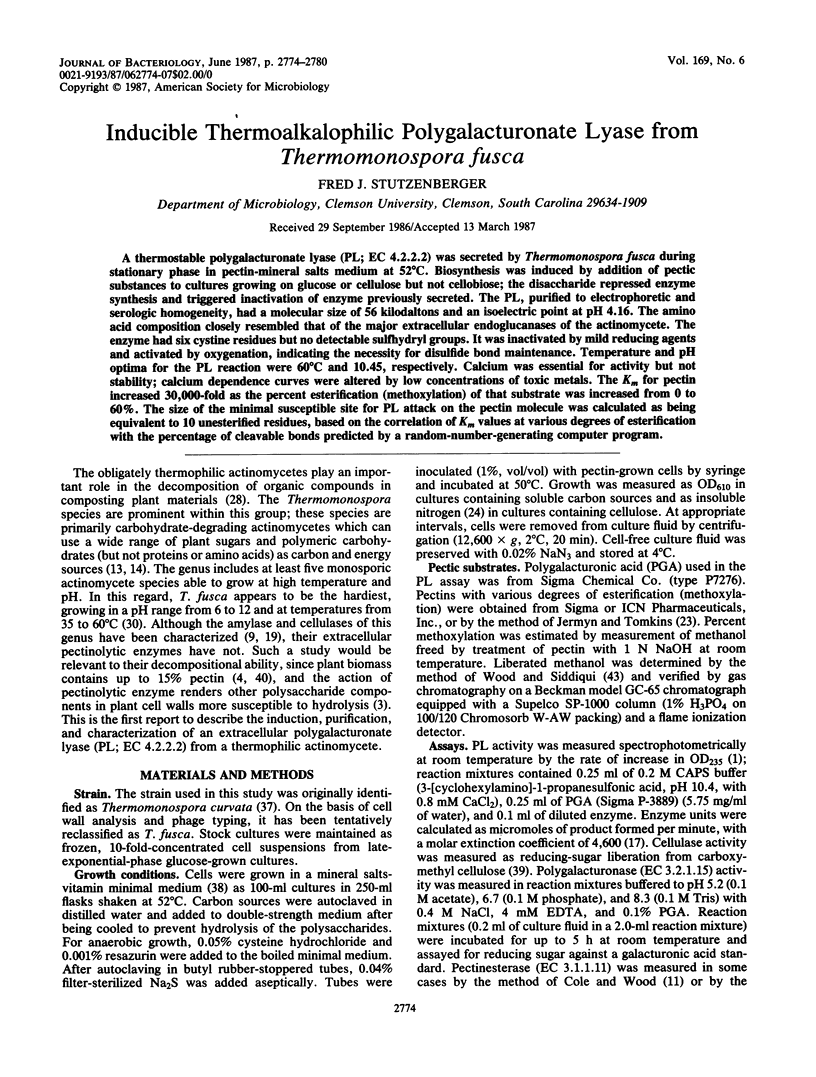
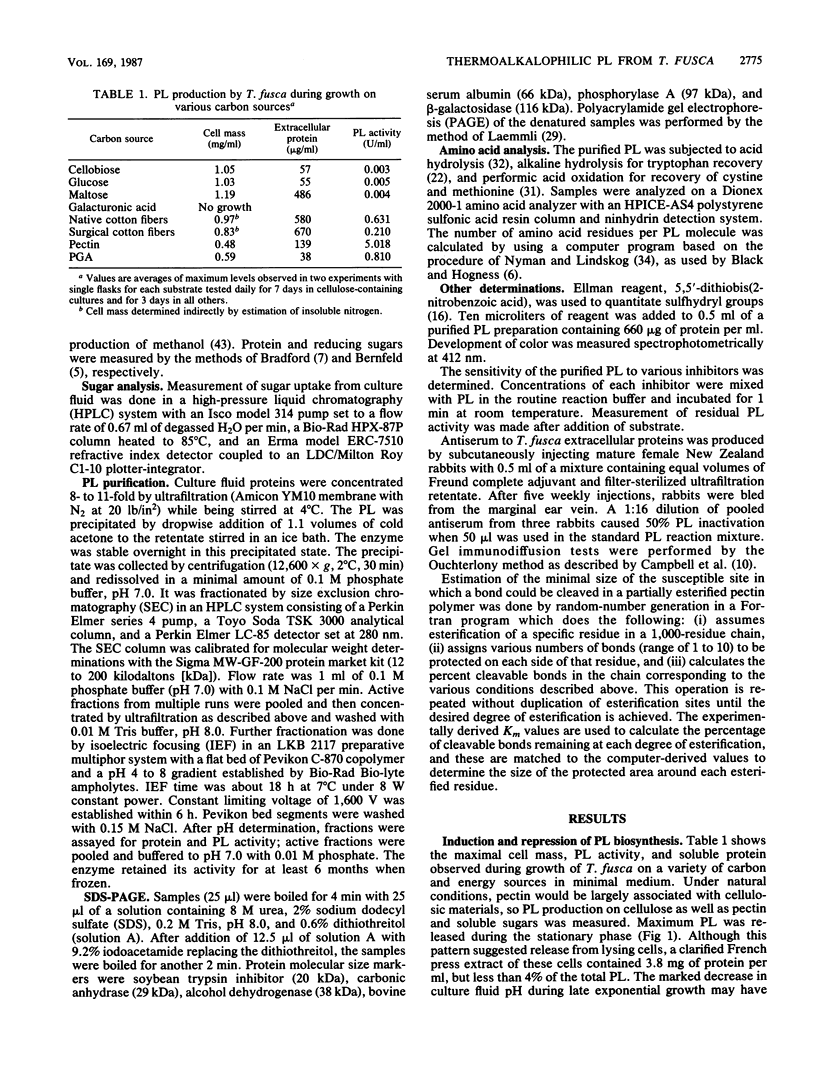

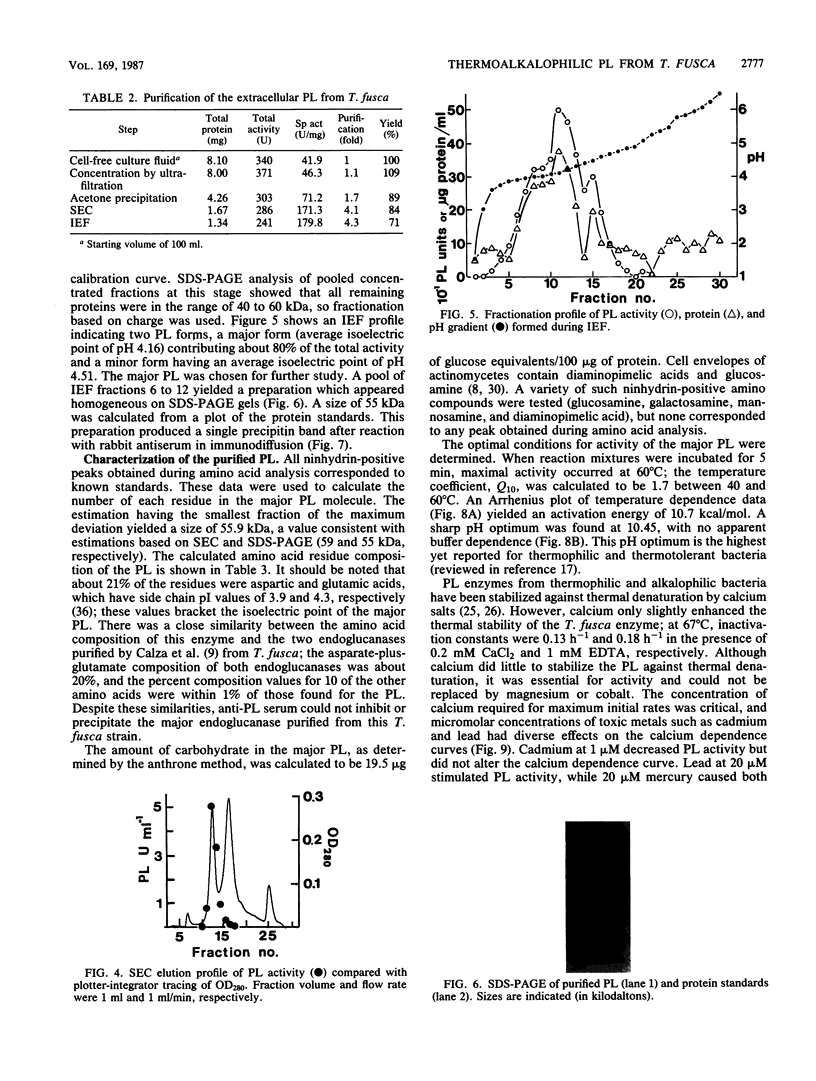
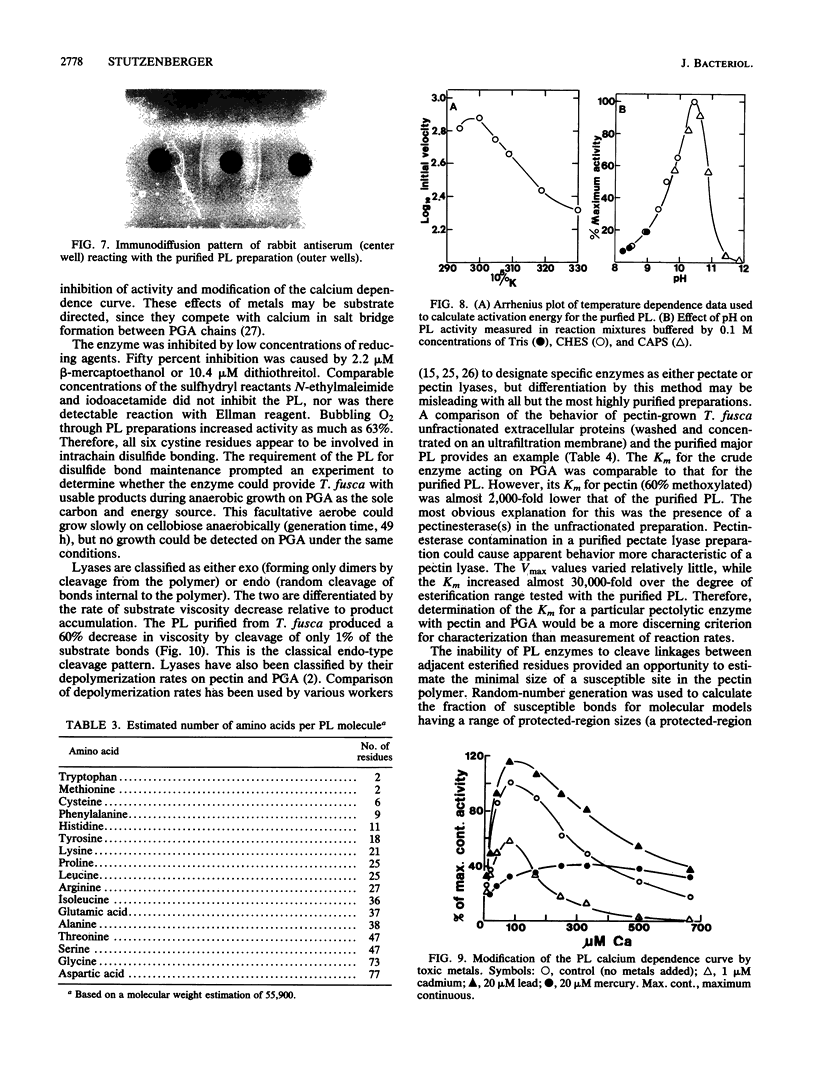
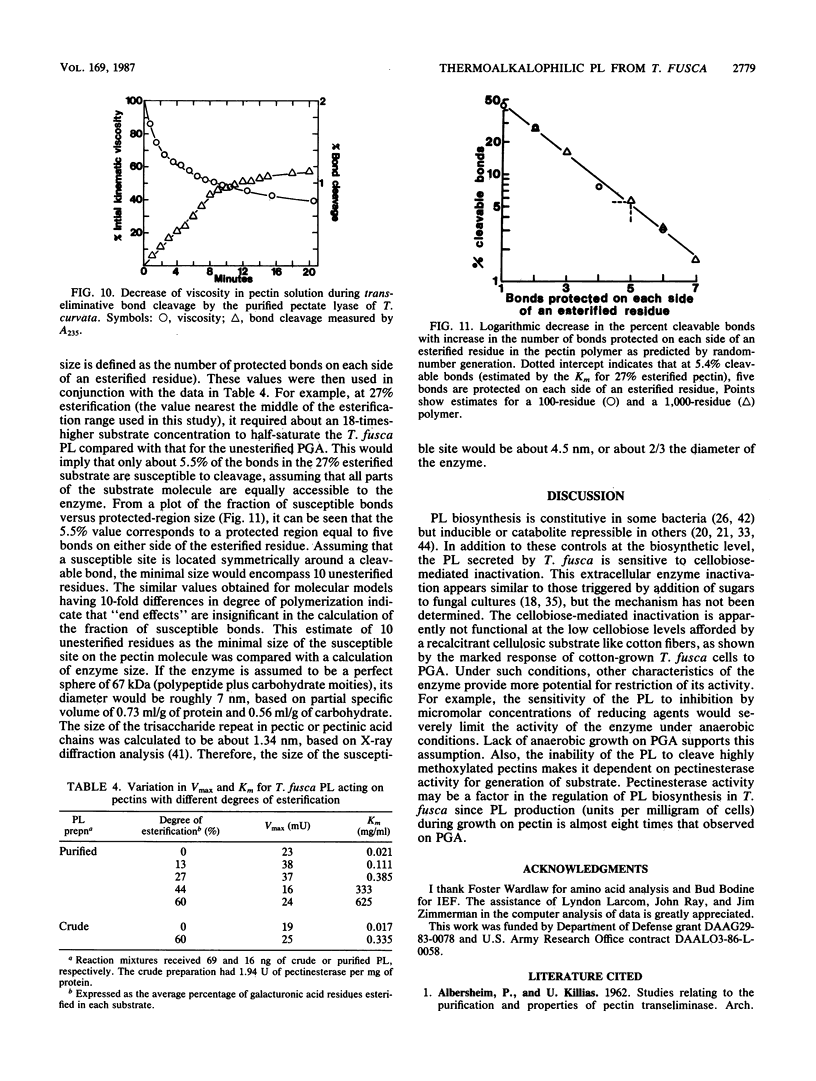
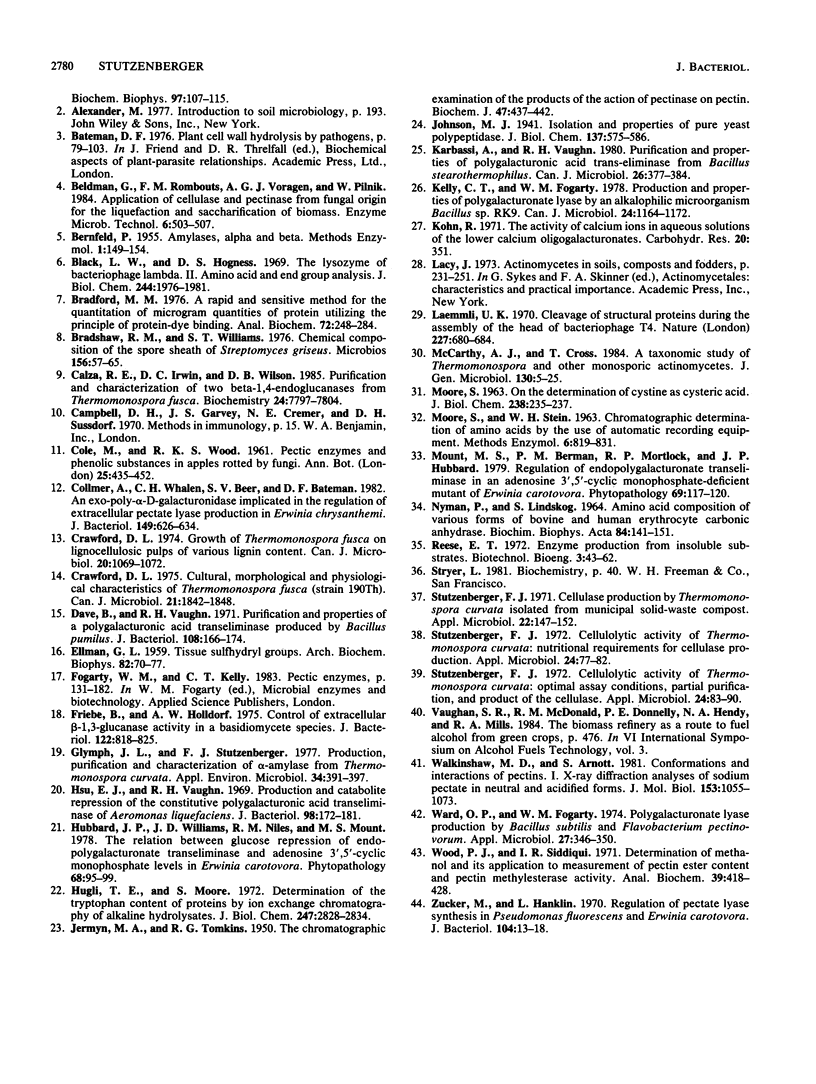
Images in this article
Selected References
These references are in PubMed. This may not be the complete list of references from this article.
- Black L. W., Hogness D. S. The lysozyme of bacteriophage lambda. II. Amino acid and end group analysis. J Biol Chem. 1969 Apr 25;244(8):1976–1981. [PubMed] [Google Scholar]
- Bradford M. M. A rapid and sensitive method for the quantitation of microgram quantities of protein utilizing the principle of protein-dye binding. Anal Biochem. 1976 May 7;72:248–254. doi: 10.1006/abio.1976.9999. [DOI] [PubMed] [Google Scholar]
- Bradshaw R. M., Williams S. T. Chemical composition of the spore sheath of Streptomyces griseus. Microbios. 1976;15(59):57–65. [PubMed] [Google Scholar]
- Collmer A., Whalen C. H., Beer S. V., Bateman D. F. An exo-poly-alpha-D-galacturonosidase implicated in the regulation of extracellular pectate lyase production in Erwinia chrysanthemi. J Bacteriol. 1982 Feb;149(2):626–634. doi: 10.1128/jb.149.2.626-634.1982. [DOI] [PMC free article] [PubMed] [Google Scholar]
- Crawford D. L. Cultural, morphological, and physiological characteristics of Thermomonospora fusca (strain 190Th). Can J Microbiol. 1975 Nov;21(11):1842–1848. doi: 10.1139/m75-267. [DOI] [PubMed] [Google Scholar]
- Crawford D. L. Growth of Thermomonospora fusca on lignocellulosic pulps of varying lignin content. Can J Microbiol. 1974 Jul;20(7):1069–1072. doi: 10.1139/m74-167. [DOI] [PubMed] [Google Scholar]
- Davé B. A., Vaughn R. H. Purification and properties of an polygalacturonic acid trans-eliminase produced by Bacillus pumilus. J Bacteriol. 1971 Oct;108(1):166–174. doi: 10.1128/jb.108.1.166-174.1971. [DOI] [PMC free article] [PubMed] [Google Scholar]
- ELLMAN G. L. Tissue sulfhydryl groups. Arch Biochem Biophys. 1959 May;82(1):70–77. doi: 10.1016/0003-9861(59)90090-6. [DOI] [PubMed] [Google Scholar]
- Friebe B., Holldorf A. W. Control of Extracellular beta-1,3-glucanase activity in a basidiomycete species. J Bacteriol. 1975 Jun;122(3):818–825. doi: 10.1128/jb.122.3.818-825.1975. [DOI] [PMC free article] [PubMed] [Google Scholar]
- Glymph J. L., Stutzenberger F. J. Production, purification, and characterization of alpha-amylase from Thermomonospora curvata. Appl Environ Microbiol. 1977 Oct;34(4):391–397. doi: 10.1128/aem.34.4.391-397.1977. [DOI] [PMC free article] [PubMed] [Google Scholar]
- Hsu E. J., Vaughn R. H. Production and catabolite repression of the constitutive polygalacturonic acid trans-eliminase of Aeromonas liquefaciens. J Bacteriol. 1969 Apr;98(1):172–181. doi: 10.1128/jb.98.1.172-181.1969. [DOI] [PMC free article] [PubMed] [Google Scholar]
- Hugli T. E., Moore S. Determination of the tryptophan content of proteins by ion exchange chromatography of alkaline hydrolysates. J Biol Chem. 1972 May 10;247(9):2828–2834. [PubMed] [Google Scholar]
- JERMYN M. A., TOMKINS R. G. The chromatographic examination of the products of the action of pectinase on pectin. Biochem J. 1950 Oct;47(4):437–442. doi: 10.1042/bj0470437. [DOI] [PMC free article] [PubMed] [Google Scholar]
- Karbassi A., Vaughn R. H. Purification and properties of polygalacturonic acid trans-eliminase from Bacillus stearothermophilus. Can J Microbiol. 1980 Mar;26(3):377–384. doi: 10.1139/m80-061. [DOI] [PubMed] [Google Scholar]
- Kelly C. T., Fogarty W. M. Production and properties of polygalacturonate lyase by an alkalophilic microorganism Bacillus sp. RK9. Can J Microbiol. 1978 Oct;24(10):1164–1172. doi: 10.1139/m78-190. [DOI] [PubMed] [Google Scholar]
- Kohn R. The activity of calcium ions in aqueous solutions of the lower calcium oligogalacturonates. Carbohydr Res. 1971 Dec;20(2):351–356. doi: 10.1016/s0008-6215(00)81389-0. [DOI] [PubMed] [Google Scholar]
- Laemmli U. K. Cleavage of structural proteins during the assembly of the head of bacteriophage T4. Nature. 1970 Aug 15;227(5259):680–685. doi: 10.1038/227680a0. [DOI] [PubMed] [Google Scholar]
- NYMAN P., LINDSKOG S. AMINO ACID COMPOSITION OF VARIOUS FORMS OF BOVINE AND HUMAN ERYTHROCYTE CARBONIC ANHYDRASE. Biochim Biophys Acta. 1964 Apr 6;85:141–151. doi: 10.1016/0926-6569(64)90174-9. [DOI] [PubMed] [Google Scholar]
- Stutzenberger F. J. Cellulase production by Thermomonospora curvata isolated from municipal solid waste compost. Appl Microbiol. 1971 Aug;22(2):147–152. doi: 10.1128/am.22.2.147-152.1971. [DOI] [PMC free article] [PubMed] [Google Scholar]
- Stutzenberger F. J. Cellulolytic activity of Thermomonospora curvata: nutritional requirments for cellulase production. Appl Microbiol. 1972 Jul;24(1):77–82. doi: 10.1128/am.24.1.77-82.1972. [DOI] [PMC free article] [PubMed] [Google Scholar]
- Stutzenberger F. J. Cellulolytic activity of Thermomonospora curvata: optimal assay conditions, partial purification, and product of the cellulase. Appl Microbiol. 1972 Jul;24(1):83–90. doi: 10.1128/am.24.1.83-90.1972. [DOI] [PMC free article] [PubMed] [Google Scholar]
- Walkinshaw M. D., Arnott S. Conformation and interactions of pectins. I. X-ray diffraction analyses of sodium pectate in neutral and acidified forms. J Mol Biol. 1981 Dec 25;153(4):1055–1073. doi: 10.1016/0022-2836(81)90467-8. [DOI] [PubMed] [Google Scholar]
- Ward O. P., Fogarty W. M. Polygalacturonate lyase production by Bacillus subtilis and Flavobacterium pectinovorum. Appl Microbiol. 1974 Feb;27(2):346–350. doi: 10.1128/am.27.2.346-350.1974. [DOI] [PMC free article] [PubMed] [Google Scholar]
- Wood P. J., Siddiqui I. R. Determination of methanol and its application to measurement of pectin ester content and pectin methyl esterase activity. Anal Biochem. 1971 Feb;39(2):418–428. doi: 10.1016/0003-2697(71)90432-5. [DOI] [PubMed] [Google Scholar]
- Zucker M., Hankin L. Regulation of pectate lyase synthesis in Pseudomonas fluorescens and Erwinia carotovora. J Bacteriol. 1970 Oct;104(1):13–18. doi: 10.1128/jb.104.1.13-18.1970. [DOI] [PMC free article] [PubMed] [Google Scholar]



